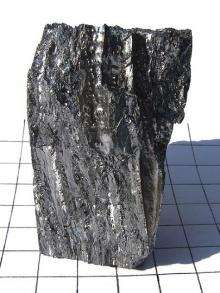April 21, 2011 feature
Primordial beryllium could reveal insights into the Big Bang

(PhysOrg.com) -- Some chemical elements appear much more abundantly in nature than others, which is partly due to how the elements originally formed. Scientists know that the light elements (hydrogen, deuterium, helium, and traces of lithium) were produced by fusion in the early Universe. Today, lithium, beryllium, and boron are constantly being produced in cosmic rays, while the heavier elements (up to iron) are formed by fusion in stars. Elements heavier than iron are formed by supernovae.
Physicists Maxim Pospelov of the Perimeter Institute for Theoretical Physics in Waterloo, Ontario, and the University of Victoria in Victoria, British Columbia, along with Josef Pradler, also of the Perimeter Institute, explain in a new study that investigating how chemical elements are produced can lead to a better understanding of what happened during the early Universe. The physicists have specifically investigated how beryllium could be used as a “Big Bang calorimeter” to probe the energy levels in the early Universe, and also to serve as a constraint on new physics models. Their study is published in a recent issue of Physical Review Letters.
In their analysis, Pospelov and Pradler have investigated what may have happened during Big Bang nucleosynthesis (BBN), a period that started about 3 minutes after the Big Bang and lasted for about 20 minutes. It was during this time that the first elements were produced, with the lightest elements in the greatest abundance. For instance, at that time only one lithium nucleus existed for every 10 billion hydrogen atoms. After BBN ended, the Universe became too cool to allow any further nuclear fusion reactions to take place.
Until now, researchers have thought that beryllium could not have been produced during rather generic circumstances in BBN. But here, Pospelov and Pradler have shown that, when an unknown particle X decays under the conditions during BBN, it can release a large amount of energy that can lead to the production of 9Be, which is the only stable isotope of beryllium. The formation of 9Be occurs at the end of a chain of transformations, going through a few light element isotopes including 6He, eventually leading to the beryllium isotope. When the physicists calculated the efficiency of this chain of transformations, they found that the process could produce a beryllium/hydrogen abundance ratio of 10-14 (or 1 gram of beryllium per 10 million tonnes of hydrogen).
“Looking at the abundance pattern of the light elements allows us to gain insight into the dynamics of the early Universe when it was a billion times hotter than it is today and only a few hundred seconds old,” Pradler told PhysOrg.com. “In our work we show that any process, such as the decay or annihilation of a relic particle species X, that dumps hadronic energy into this primordial mix sets off a chain of non-thermal nuclear reactions which culminates in the fusion of beryllium -- an element otherwise out of reach by primordial standards.”
Beryllium, along with lithium, can be observed in metal-deficient stars, which were formed from the nearly pristine interstellar gas. Scientists can identify the elements by using stellar spectroscopy to detect each element’s individual atomic resonance lines. Previous research has found that, in contrast to lithium, the beryllium in these stars is not of primordial origin. Whereas lithium’s value as a function of stellar metallicity plateaus at low metallicities, there is no plateau for beryllium. Instead, beryllium seems to be decreasing to smaller and smaller values as stellar metallicity decreases, and thus to more pristine mixtures of the interstellar gas from which the star formed.
As the scientists explain, what makes beryllium so powerful in these stars is that, unlike lithium, it is not really affected by any stellar dynamics. Whereas lithium is fragile and may have been destroyed in the stars, beryllium is much stronger. For this reason, beryllium could be more useful for constraining nonstandard BBN models.
“Many new particle physics models, including those which are currently searched for at the Large Hadron Collider (LHC) at CERN, predict long-lived massive states X,” Pradler said. “As the LHC is pushing the terrestrial energy frontier to search for new physics, these X particles could have copiously been produced in the Big Bang. The conversion of X's rest mass into hadronic energy during its decay can be detected in an elevated beryllium abundance. The more energy is dumped, the higher the Be abundance will be. The isotope acts a calorimeter.”
The scientists hope that future observations of metal-deficient stars may further tighten the limit on beryllium's primordial abundance, and help to strengthen beryllium as a constraint on models of new physics.
“One class of models our study targets are supersymmetric extensions of the Standard Model in which each ordinary particle gets assigned a 'doppelgänger' state,” Pradler said. “These states are typically heavy and it may well be that one of them has a lifetime such that it decays during or shortly after BBN. Indeed, it is even conceivable that the dark matter itself was produced in such decays. BBN can act as a powerful probe to test new physics beyond the Standard Model, and every model has to pass this cosmological consistency check.”
More information: Maxim Pospelov and Josef Pradler. “Primordial Beryllium as a Big Bang Calorimeter.” Physical Review Letters 106, 121305 (2011). DOI: 10.1103/PhysRevLett.106.121305
Copyright 2010 PhysOrg.com.
All rights reserved. This material may not be published, broadcast, rewritten or redistributed in whole or part without the express written permission of PhysOrg.com.




















